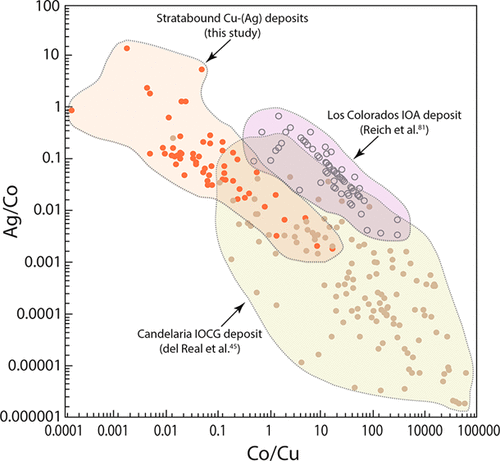当前位置:
X-MOL 学术
›
ACS Earth Space Chem.
›
论文详情
Our official English website, www.x-mol.net, welcomes your
feedback! (Note: you will need to create a separate account there.)
Trace Element Geochemistry of Pyrite from Bitumen-Bearing Stratabound Cu–(Ag) Deposits, Northern Chile
ACS Earth and Space Chemistry ( IF 2.9 ) Pub Date : 2021-02-19 , DOI: 10.1021/acsearthspacechem.0c00321 Andrea Herazo 1, 2 , Martin Reich 1, 2 , Fernando Barra 1, 2 , Diego Morata 1, 2 , Irene del Real 1, 2
ACS Earth and Space Chemistry ( IF 2.9 ) Pub Date : 2021-02-19 , DOI: 10.1021/acsearthspacechem.0c00321 Andrea Herazo 1, 2 , Martin Reich 1, 2 , Fernando Barra 1, 2 , Diego Morata 1, 2 , Irene del Real 1, 2
Affiliation

|
The Coastal Cordillera metallogenic province of northern Chile comprises several styles of mineralization, including stratabound Cu–(Ag), iron oxide–copper–gold (IOCG), iron oxide–apatite (IOA), and porphyry Cu deposits. Stratabound Cu–(Ag) or “Manto-type” deposits from the Coastal Cordillera of northern Chile formed during two main periods, i.e., the Late Jurassic and Early Cretaceous. These deposits are hosted in volcanic and volcano sedimentary rocks, and some of them are characterized by the presence of solid hydrocarbons (bitumen), which are closely associated with pyrite and Cu–(Fe) sulfides. Although pyrite is ubiquitous and in some cases abundant in this deposit type, its trace element content and mineralogical form of incorporation, i.e., nanoscale inclusions or solid solution, remains largely unknown. In this study, we focus on pyrite from bitumen-bearing stratabound Cu–(Ag) deposits from northern Chile to assess the formation conditions of these deposits by using a combination of electron probe microanalysis (EPMA) and laser ablation inductively coupled plasma mass spectrometry (LA-ICP-MS). Our results show that pyrite from stratabound Cu–(Ag) deposits hosts significant concentrations of Cu, As, Mn, Pb, Tl, Co, Ni, V, and Mo that range from a few parts per million (ppm) to weight percent (wt %) levels. Among all elements analyzed, Cu, As, Mn, and Tl are the most abundant, reaching concentrations up to ∼2.8 (Cu), ∼0.25 (As), ∼2.4 (Mn), and ∼0.09 wt % (Tl). These elements occur dominantly in solid solution, although LA-ICP-MS depth profiles suggest the presence of micro- to nanosized mineral inclusions. Pyrite from stratabound Cu–(Ag) deposits is characterized by distinctively lower Co/Ni (∼0.1 to 10) and Co/Cu ratios (∼0.0001 to 10) and higher Ag/Co values (∼0.001 to 10) than pyrite from Cretaceous iron oxide-apatite (IOA) and IOCG deposits from the Coastal Cordillera metallogenic province. We interpret these variations as resulting from differences in physicochemical parameters of the pyrite-forming fluid, i.e., temperature, redox conditions, and source of metals/sulfur. Based on our data we conclude that pyrite from the studied stratabound Cu–(Ag) deposits formed at relatively low temperatures (100 to ∼300 °C), reducing conditions, and with a strong sedimentary component as reflected in its trace element geochemistry. Therefore, our data supports the use of the trace element content of pyrite to fingerprint the formation conditions of ore mineralization in different deposit types with possible applications as a vectoring tool within the Coastal Cordillera metallogenic province and elsewhere.
中文翻译:

智利北部含沥青层积铜(Ag)矿床中硫铁矿的微量元素地球化学
智利北部沿海科迪勒拉成矿省包括几种矿化类型,包括地层结合的Cu-(Ag),氧化铁-铜-金(IOCG),氧化铁-磷灰石(IOA)和斑岩型铜矿床。来自智利北部沿海山脉的地层结合型Cu-(Ag)或“ Manto型”矿床形成于两个主要时期,即侏罗纪晚期和白垩纪早期。这些沉积物存在于火山岩和火山沉积岩中,其中一些特征是存在固态碳氢化合物(沥青),而固态碳氢化合物与黄铁矿和硫化铜(Fe)密切相关。尽管黄铁矿无处不在,并且在某些情况下这种矿床类型丰富,但其痕量元素含量和掺入的矿物学形式(即纳米级夹杂物或固溶体)仍然未知。在这项研究中,我们重点研究了智利北部含沥青地层结合的Cu-(Ag)矿床中的黄铁矿,通过结合使用电子探针微分析(EPMA)和激光烧蚀电感耦合等离子体质谱法(LA-ICP-S)来评估这些矿床的形成条件。多发性硬化症)。我们的结果表明,分层结合的Cu-(Ag)矿床中的黄铁矿含有大量的Cu,As,Mn,Pb,Tl,Co,Ni,V和Mo,其浓度范围从百万分之几(ppm)到重量百分比( wt%)水平。在所有被分析的元素中,Cu,As,Mn和Tl最丰富,其浓度高达〜2.8(Cu),〜0.25(As),〜2.4(Mn)和〜0.09 wt%(Tl)。这些元素主要在固溶体中发生,尽管LA-ICP-MS的深度剖面表明存在微米级至纳米级的矿物包裹体。与白垩纪的黄铁矿相比,分层结合的Cu-(Ag)矿床的黄铁矿具有明显更低的Co / Ni(〜0.1至10)和Co / Cu比(〜0.0001至10)以及更高的Ag / Co值(〜0.001至10)的特点。沿海科迪勒拉成矿省的氧化铁磷灰石(IOA)和IOCG矿床。我们将这些变化解释为是由黄铁矿形成流体的物理化学参数(即温度,氧化还原条件和金属/硫源)的差异引起的。根据我们的数据,我们得出的结论是,来自研究的地层结合的Cu-(Ag)矿床中的黄铁矿是在相对较低的温度(100至〜300°C),还原条件下形成的,并具有很强的沉积成分,这在其微量元素地球化学中得到了反映。所以,
更新日期:2021-03-18
中文翻译:

智利北部含沥青层积铜(Ag)矿床中硫铁矿的微量元素地球化学
智利北部沿海科迪勒拉成矿省包括几种矿化类型,包括地层结合的Cu-(Ag),氧化铁-铜-金(IOCG),氧化铁-磷灰石(IOA)和斑岩型铜矿床。来自智利北部沿海山脉的地层结合型Cu-(Ag)或“ Manto型”矿床形成于两个主要时期,即侏罗纪晚期和白垩纪早期。这些沉积物存在于火山岩和火山沉积岩中,其中一些特征是存在固态碳氢化合物(沥青),而固态碳氢化合物与黄铁矿和硫化铜(Fe)密切相关。尽管黄铁矿无处不在,并且在某些情况下这种矿床类型丰富,但其痕量元素含量和掺入的矿物学形式(即纳米级夹杂物或固溶体)仍然未知。在这项研究中,我们重点研究了智利北部含沥青地层结合的Cu-(Ag)矿床中的黄铁矿,通过结合使用电子探针微分析(EPMA)和激光烧蚀电感耦合等离子体质谱法(LA-ICP-S)来评估这些矿床的形成条件。多发性硬化症)。我们的结果表明,分层结合的Cu-(Ag)矿床中的黄铁矿含有大量的Cu,As,Mn,Pb,Tl,Co,Ni,V和Mo,其浓度范围从百万分之几(ppm)到重量百分比( wt%)水平。在所有被分析的元素中,Cu,As,Mn和Tl最丰富,其浓度高达〜2.8(Cu),〜0.25(As),〜2.4(Mn)和〜0.09 wt%(Tl)。这些元素主要在固溶体中发生,尽管LA-ICP-MS的深度剖面表明存在微米级至纳米级的矿物包裹体。与白垩纪的黄铁矿相比,分层结合的Cu-(Ag)矿床的黄铁矿具有明显更低的Co / Ni(〜0.1至10)和Co / Cu比(〜0.0001至10)以及更高的Ag / Co值(〜0.001至10)的特点。沿海科迪勒拉成矿省的氧化铁磷灰石(IOA)和IOCG矿床。我们将这些变化解释为是由黄铁矿形成流体的物理化学参数(即温度,氧化还原条件和金属/硫源)的差异引起的。根据我们的数据,我们得出的结论是,来自研究的地层结合的Cu-(Ag)矿床中的黄铁矿是在相对较低的温度(100至〜300°C),还原条件下形成的,并具有很强的沉积成分,这在其微量元素地球化学中得到了反映。所以,











































 京公网安备 11010802027423号
京公网安备 11010802027423号